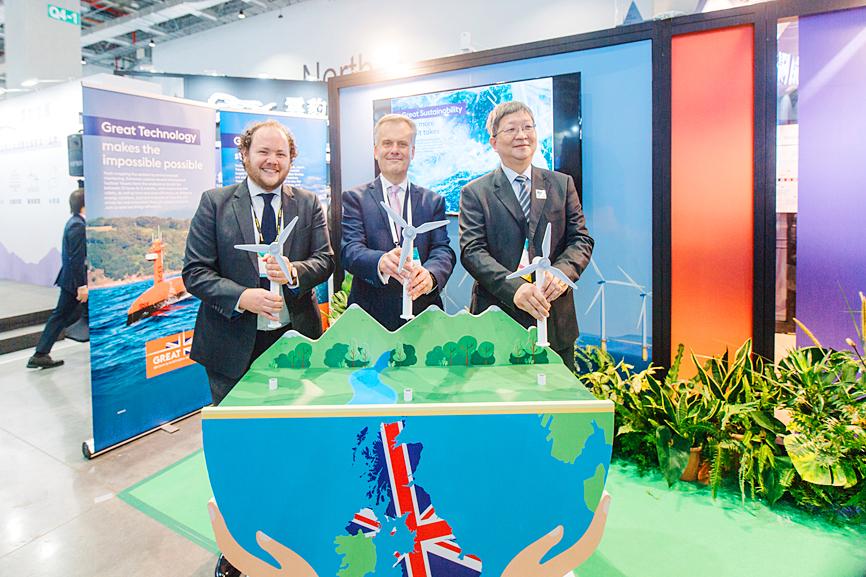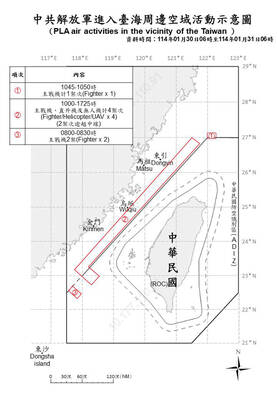Taiwan’s solar and wind energy installations would generate revenue of more than NT$2 trillion (US$72.09 billion) and create 160,000 jobs by 2025, President Tsai Ing-wen (蔡英文) said yesterday, reiterating the nation’s resolve to energy transition.
Tsai made the remarks at the opening of the three-day Energy Taiwan exposition at the Nangang Exhibition Center’s Hall 2 in Taipei.
Exports of Taiwan’s semiconductor manufacturing facilities in the third quarter exceeded US$7.3 billion, making it the biggest market in the world, Tsai said, citing Semiconductor Equipment and Materials International data.

Photo courtesy of the British Office Taipei
The booming semiconductor industry is increasing demand for green power, while the government is committed to expanding the green energy industry, she said.
By 2025, the nation’s wind and solar power installations would create investments of up to NT$1.7 trillion, revenue of more than NT$2 trillion and 160,000 jobs, Tsai said.
“The UK is supporting Taiwan in its energy transition,” British Representative to Taiwan John Dennis said at the British pavilion later. “We are partnering with Taiwan to turbocharge its offshore wind sector and become the regional leader in clean growth.”
“Now, Taiwan is the UK’s largest offshore wind market in Asia-Pacific,” Dennis said. “I would like to congratulate the Bureau of Energy and the Ministry of Economic Affairs on their third round offshore wind development plan, and their target to achieve 20.5 gigawatts in capacity by 2035.”
Taiwan, although it was not part of the COP26 negotiations, has an important role to play, as it is the world’s 21st-largest economy and a top-25 emitter of carbon dioxide, he said.
The envoy also welcomed Taiwan’s commitment to carbon neutrality by 2050 and its plan to legislate a carbon pricing scheme.
“The UK’s credit agency ... has provided more than £500 million [US$659.78 million] in credit guarantees to three offshore wind farms in Taiwan,” he said.
It is the first time that the British Office Taipei has had a UK-themed pavilion at the annual energy exposition, the office said.
There are more than 30 British offshore wind companies with offices in Taiwan, with eight — Aggreko International Projects, Correll Electrical Engineering Taiwan Branch, CWind Taiwan, Flotation Energy Taiwan, James Fisher Renewables, Offshore Wind Consultants Taiwan, Taiwan Mott MacDonald and Taylor Hopkinson — exhibiting, it said.
The companies are to demonstrate the breadth of British expertise, including offshore wind farm planning and construction, engineering consultancy, crew transfer vessels, operations and maintenance, blade services, floating wind technology, and temporary power and temperature solutions for offshore wind farms, it said.
Also at the exposition are a handful of German and Dutch companies, including RWE Renewables Taiwan, Phoenix Contact and Boskalis Hwachi Offshore Wind Taiwan.
The COVID-19 pandemic has hindered the progress of some offshore installations, but the situation is expected to improve from next year, German Offshore-Wind Initiative Taiwan representative David Chiang (蔣大巍) said.
Many energy developers are competing for the third phase of Taiwan’s offshore wind farm plan, after the ministry in July started accepting applications, he said.
Floating wind technology is expected to become a new trend, Chiang said, adding that the government should ensure the consistency of energy policy to minimize the risks for energy developers.

Taiwanese actress Barbie Hsu (徐熙媛) has died of pneumonia at the age of 48 while on a trip to Japan, where she contracted influenza during the Lunar New Year holiday, her sister confirmed today through an agent. "Our whole family came to Japan for a trip, and my dearest and most kindhearted sister Barbie Hsu died of influenza-induced pneumonia and unfortunately left us," Hsu's sister and talk show hostess Dee Hsu (徐熙娣) said. "I was grateful to be her sister in this life and that we got to care for and spend time with each other. I will always be grateful to

UNITED: The premier said Trump’s tariff comments provided a great opportunity for the private and public sectors to come together to maintain the nation’s chip advantage The government is considering ways to assist the nation’s semiconductor industry or hosting collaborative projects with the private sector after US President Donald Trump threatened to impose a 100 percent tariff on chips exported to the US, Premier Cho Jung-tai (卓榮泰) said yesterday. Trump on Monday told Republican members of the US Congress about plans to impose sweeping tariffs on semiconductors, steel, aluminum, copper and pharmaceuticals “in the very near future.” “It’s time for the United States to return to the system that made us richer and more powerful than ever before,” Trump said at the Republican Issues Conference in Miami, Florida. “They

GOLDEN OPPORTUNITY: Taiwan must capitalize on the shock waves DeepSeek has sent through US markets to show it is a tech partner of Washington, a researcher said China’s reported breakthrough in artificial intelligence (AI) would prompt the US to seek a stronger alliance with Taiwan and Japan to secure its technological superiority, a Taiwanese researcher said yesterday. The launch of low-cost AI model DeepSeek (深度求索) on Monday sent US tech stocks tumbling, with chipmaker Nvidia Corp losing 16 percent of its value and the NASDAQ falling 612.46 points, or 3.07 percent, to close at 19,341.84 points. On the same day, the Philadelphia Stock Exchange Semiconductor Sector index dropped 488.7 points, or 9.15 percent, to close at 4,853.24 points. The launch of the Chinese chatbot proves that a competitor can

TAIWAN DEFENSE: The initiative would involve integrating various systems in a fast-paced manner through the use of common software to obstruct a Chinese invasion The first tranche of the US Navy’s “Replicator” initiative aimed at obstructing a Chinese invasion of Taiwan would be ready by August, a US Naval Institute (USNI) News report on Tuesday said. The initiative is part of a larger defense strategy for Taiwan, and would involve launching thousands of uncrewed submarines, surface vessels and aerial vehicles around Taiwan to buy the nation and its partners time to assemble a response. The plan was first made public by the Washington Post in June last year, when it cited comments by US Indo-Pacific Commander Admiral Samuel Paparo on the sidelines of the Shangri-La Dialogue